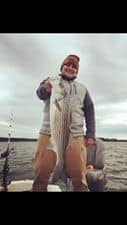Striped bass are migratory fish. The weather and the season determine how they travel and feed. It is well known that the stripers seek out cooler waters, so it is wise to check the water conditions and temperatures before you head out.

There is, however, more than just the water temperature and conditions to consider when you are looking to fish for striped bass. You also need to be cautious of the time of day you go out and also the tide.
All areas where striped bass are most sought after will have a tide report that you can check. The recommended tide time is 2-3 hours before high tide and 2-3 hours after low tide. But we are going to delve a little deeper into tide times and what tide is best.
Get the Best Tide Right on your Watch! See It HERE.
The Best tide to fish for striped bass
It may sound contradictory, but the two best times to catch striped bass is when the tide comes in and the current is at its strongest. But, when there is no current at all, is prime time as well.
During peak tide, the current is stronger. This will stir up the sediment near the shoreline. Baitfish feed on the sediment and stripers feed on the baitfish. BINGO! Well, not quite.
If it was that easy, we would be having this discussion right now. The same effect applies if you fish right after a stormy or windy weather period.
Incase you need a good solid combo rod and reel, here is a well rated model.
When the current is weak, during slack tide, the stripers hunker down. Trolling with live bait at this time will provide a great opportunity to catch some stripers.
Fishing after a storm, on a cool day, or at peak tides will boost your chances of catching striped bass, but one must also consider the location and the season. Feeding habitats change depending on the season and the location of where you are fishing.
One thing you will need to do is understand the tide in your area or the area where you plan to fish for the stripers. Remember, a current moves the water side to side, while a tide moves the water up and down.
Believe it or not, the position of the sun and the moon affects the tide! Tides are large waves that move through the ocean. High tide is when the tide comes in and raises the water level. In turn, low tide is when the tide is moving out and the water levels start to lower.
It isn’t always easy to detect when a tide will occur. Due to the length of the day, the majority of areas will experience two low tides and two high tides every 24.5 to 25 hours.
Making it so that the tides do not come in at the same time every day. One of the easiest and best ways to detect tides is to keep a close eye on the weather. Most weather channels, websites, and local game and fish departments will post tide tables, for public research and knowledge.
Two of the best tides to catch striped bass
It may sound contradictory, but the two best times to catch striped bass is when the tide comes in and the current is at its strongest. But, when there is no current at all, is prime time as well.
Stripers will stop feeding, in some areas, when the tide moves out and the current stops. When the current is strong, it brings the baitfish right to the striped bass, so they can feed without a lot of effort.
Every fish area and every fisherman will have a difference of opinion as to which tide is best to catch stripers. One guide from Montauk states that 3 hours before and after the tide, while another angler from the area states the top of the outgoing tide is the best time.
Allot of being a great striped bass angler, is going to be experienced. Knowledge of the area, habitat, tide schedule, best time of day, season, and preferred bait are things that will make you an experienced angler.
But, it is all going to take time and patience to figure out. Even then, you are going to have differences in opinion from one angler to another, based on the experiences and years of fishing the area for striper.
Tides run in 12 hour cycles
Tides run in approximately 12-hour cycles, starting with the outgoing tide which lasts about 6 hours. In between incoming and outgoing tides, you will have about 45 minutes to one hour of slack water before the next tide starts to roll in.
Even if fishing guides do not announce it, advertise it or talk about it, they live by the tide schedules every single day. They know when and where every single tide in the area comes in and goes out. That is why hiring a fishing guide is recommended if you are taking a trip to somewhere you have never fished before.
It is their passion and their jobs to know everything that they can and need to for that particular area, and most of them have spent the majority of their lives on the water figuring all of this out. They live to fish and to teach others the things they have learned.
They love to share their tips, tricks, and to teach others. If you are going to go at it on your own, it will take a lot of time, patience, and log keeping to figure out what works best for you in your area.
Three foolproof ways to tell which tide fishes best.
One professional fishing guide offers 3 simple steps to tell which tide fishes best, in the Cape Cod area.
His first tip is to observe the slope of the beach. Fishing during the low stages of the tide can be more beneficial on a gradually sloped beach because you can walk out into the water and onto flats or sandbars and cast your line.
At a vertically sloped beach, he suggests fishing at high tide. Striped bass will often cruise extremely close to the shoreline during high tide.
The second tip is being able to identify the stage of the tide and figure out where most stripers are during each stage. One spot in the Cape Cod area, the stripers will linger outside the inlets, waiting for the high tide to rush them through the estuary.
In another spot, the striped bass prefers the low tide because the baitfish get trapped in holes and troughs. If you are fishing from the shore, this would be a perfect time to look for those areas where there are sand bars just off the shore. when the baitfish get caught up in these trough made by the sand bars.
That’s a great time to cast out from shore. you can see the troughs from shore by watching for lines of white water made up from the waves crashing over the sand bars but before they hit the beaches. there will be white bubbles and a dark-colored area to each side.
you can try the shore side of the sand bar first and if you have no luck then give the other side a try. A lot of times the stripers will pile bait fish up against these sandbars and you will have your chance to attract one of them to your tasty offering as well.
His third and final tip, do as much research as possible for the area you are going to fish at. Talk to anyone you can, study the tide table/charts for the area. No one wants to spend hours getting to a fishing spot and then having to wait hours for the next tide cycle to hit.
As mentioned before, hire a professional fishing guide if you will be in an unfamiliar area. They will be your best bet on having a memorable and productive fishing trip.
Hey FISHMONGER – make sure to check out my FISHING RESOURCES page.
Not all tides are created equal
Tide heights are going to differ withing a 10-15 miles range. Tide tables and charts will provide you with the date, time, and height of the low tide and high tide in feet or meters. It is widely suggested that you thoroughly study the tide chart for the area you plan on going to.
If you are not prepared or you are inexperienced, some high tide areas can be very dangerous because of the strong current. You can check out the “real-time” data on currents and tides for the dates that you plan on fishing.
They post them about a week in advance, but I would focus on a day or 2 before you are going to be there. This will give you a better idea because it is in real-time, so any updates will happen immediately.
Tides Website
Tides4fishing.com provides daily and up to date tide charts for all locations. The site offers the following information:
- weather
- water temperature
- swell
- high and low tides; with the times they have or will occur and a countdown to the next tide
- rising and setting of the moon
- so-lunar activity
- moon phase
- locations
- fishing forecast
- weekly forecast
There are charts, graphs, and in-depth explanations of what you are looking at. The site offers information for North and South America, Europe, Africa, Asia, and Oceania. You will have to find someone to explain everything to you and decipher what you are seeing and reading.
There is a lot of in-depth information on this site, but if you do not understand everything you are reading, it is not going to help you when you get out on the water or shoreline.
So, my suggestion to you is; Do not skip any sections, thinking it is not important. It ALL ties together and needs to be understood that way. You can not just look at the tide schedule and nothing else.

The wind will play a factor, as will the temperatures and the conditions of the water. So please, make sure you fully understand the charts before you head out.
With all of the information here, we still have no precise or concrete answer on which tide is the best for catching the striped bass. Every angler has their own experiences, opinions, and suggestions.
Some say that high tide is the best, because of the fast-moving current and the fact that it stirs up the bait fish which attracts the stripers. Some say that the low tide is the best because of their love for trolling with live bait.
Then you also have the ones that say that in the middle of the tides is the better time to cast for a striper.
Conclusion
So, my conclusion? There is no perfect tide to catch striped bass. Just as there is no perfect lure, location, weather forecast, or water temperature.
All anyone can say for sure is that no matter where you go, there are a ton of factors that you have to take into consideration and every single angler is going to have their own opinions concerning those factors, because not all techniques, tips, or tricks work for everyone.
What works for an angler on Cape Cod is not going to work for another angler in the area, and will most definitely not work for someone who is fishing on Montauk.
What works for an angler in Alabama may not work for an angler in South Carolina. Even professional fishing guides fishing the same general area are going to have a difference in opinion on what works and what doesn’t. Which tide is best, which lure is better, what time a day is perfect, and so on.
So, my suggestion to you is; learn how to read the tide charts (every single aspect) thoroughly and once you get to your destination, ask for any clarification or tips from the other anglers in the area.
The opinions and suggestions will differ from angler to angler, but the more information you have and the more research you do, the more successful you will be.
Or, to save time and not take away from your fishing experience and time, you can also hire a professional fishing guide. They are experts in their areas, know the hot spots, the best tide that works for them and their job is to teach you those things.
Most professional fishing guides have been on the water since they were 3 or 4 years old and it has become their passion, their life, their job to know everything there is to know about the striped bass, and all the fishing tricks for their area.
The best part of hiring a professional fishing guide, besides gaining all the knowledge without missing the actual fishing; you are guaranteed to catch fish that you can take home from your vacation or weekend getaway. So, a fishing guide is a win-win for everyone involved to find what tide to fish for striped bass
So, now it is all up to you. It is time to plan that weekend fishing trip or a week-long vacation. Where are you going to go, what lake(s) are you going to fish at, what equipment are you going to take, where are you staying, what are the rules and regulations, what are the requirements as far as a fishing license or permit?
There are so many other questions that you are going to need to ask yourself as you plan your trip. But the biggest one; do you want to spend weeks before your trip deciphering tide reports and trying to figure out the best time of day, best weather, best lure, best area(s) along that lake, best water temperature and conditions?
Or, would you rather go relaxed, stress-free, and ready to catch that trophy-sized striped bass? If your answer is the latter, then all you have to do is a quick research on the professional guides in the area of your destination, and pick one!

